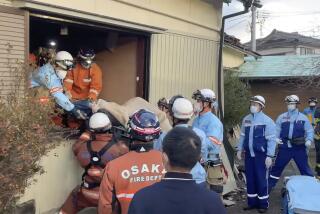Two workers’ bodies recovered at Fukushima nuclear plant
In the first confirmation of fatalities at the Fukushima Daiichi nuclear power complex, the plant’s operator on Sunday announced the recovery of the bodies of two workers who had gone missing after the devastating earthquake and tsunami.
Tokyo Electric Power Co. said Yoshiki Terashima, 21, and Kazuhiko Kokubo, 24, had rushed to the turbine room of the No. 4 reactor to inspect the power switches and test the operation valves after the March 11 earthquake. An autopsy revealed that they likely died from the force of impact from the tsunami.
Their bodies were found in the building’s basement Wednesday afternoon and had to be decontaminated, the company said, adding the announcement was delayed out of consideration for the families.
On Saturday, Tepco said highly radioactive water was leaking from a pit near a reactor into the ocean, which may partly explain the high levels of radioactivity that have been found in seawater off the coast.
Tepco said it had detected an 8-inch crack in the concrete pit holding power cables near reactor No. 2 and was working to seal the fracture. Tepco said the water was coming directly from the reactor and the radiation level was 1,000 millisieverts an hour. The annual limit of radiation exposure allowed for Fukushima workers is 250 millisieverts.
Workers pumped concrete into the shaft Saturday, but by the end of the day the flow of water into the ocean had not diminished. Engineers speculated that the water was preventing the concrete from setting, allowing it to be washed away.
Tepco officials said that on Sunday morning they would explore using a polymer — a type of quick-setting plastic — to plug the leak.
After spraying thousands of tons of water on the reactors at Fukushima over the last three weeks to keep them from overheating and releasing dangerous amounts of radiation over a wide area, Tepco is faced with the problem of great volumes of contaminated water.
With storage tanks at the facility nearing capacity, Tepco is contemplating storing the water in a giant artificial floating island offshore, Kyodo News reported. Tepco, which has been monitoring radiation levels in seawater just offshore from the plant, said it would begin sampling about nine miles off the coast.
Workers have also been spraying the grounds of the plant with a polymer in an attempt to prevent any radioactive isotopes that have been deposited there from escaping from the vicinity of the plant. The polymer acts like a kind of super-glue, binding any contaminants to the soil so they cannot be blown away.
As 25,000 Japanese and U.S. forces continued an intensive search for corpses along the tsunami-battered coastline of northern Japan, the official death toll climbed to 11,938 and the number of missing fell to 15,748, the National Police Agency said.
The number of people in emergency shelters has declined to about 165,000 from more than 200,000 in the days immediately after the massive earthquake and tsunami March 11. But concerns are growing about the health of elderly residents at the shelters, some of which still lack enough kerosene to run heaters round-the-clock. Many areas of northern Japan are still experiencing subfreezing temperatures.
A report Saturday from public broadcaster NHK reported the deaths of some elderly people who had survived the disaster. The broadcaster described harsh conditions facing older survivors, including crowded quarters, interruptions in medical regimens and a discontinuation of services such as physical therapy.
In a bit of good news, NHK reported that coast guard officials had found a dog on the roof of a house floating in waters off Miyagi prefecture. The dog, which apparently had been stranded for three weeks, was emaciated and gobbled down sausages and cookies after being saved.
Hall is a special correspondent.
Times staff writer Thomas H. Maugh II contributed to this story from Los Angeles.
More to Read
Start your day right
Sign up for Essential California for news, features and recommendations from the L.A. Times and beyond in your inbox six days a week.
You may occasionally receive promotional content from the Los Angeles Times.







